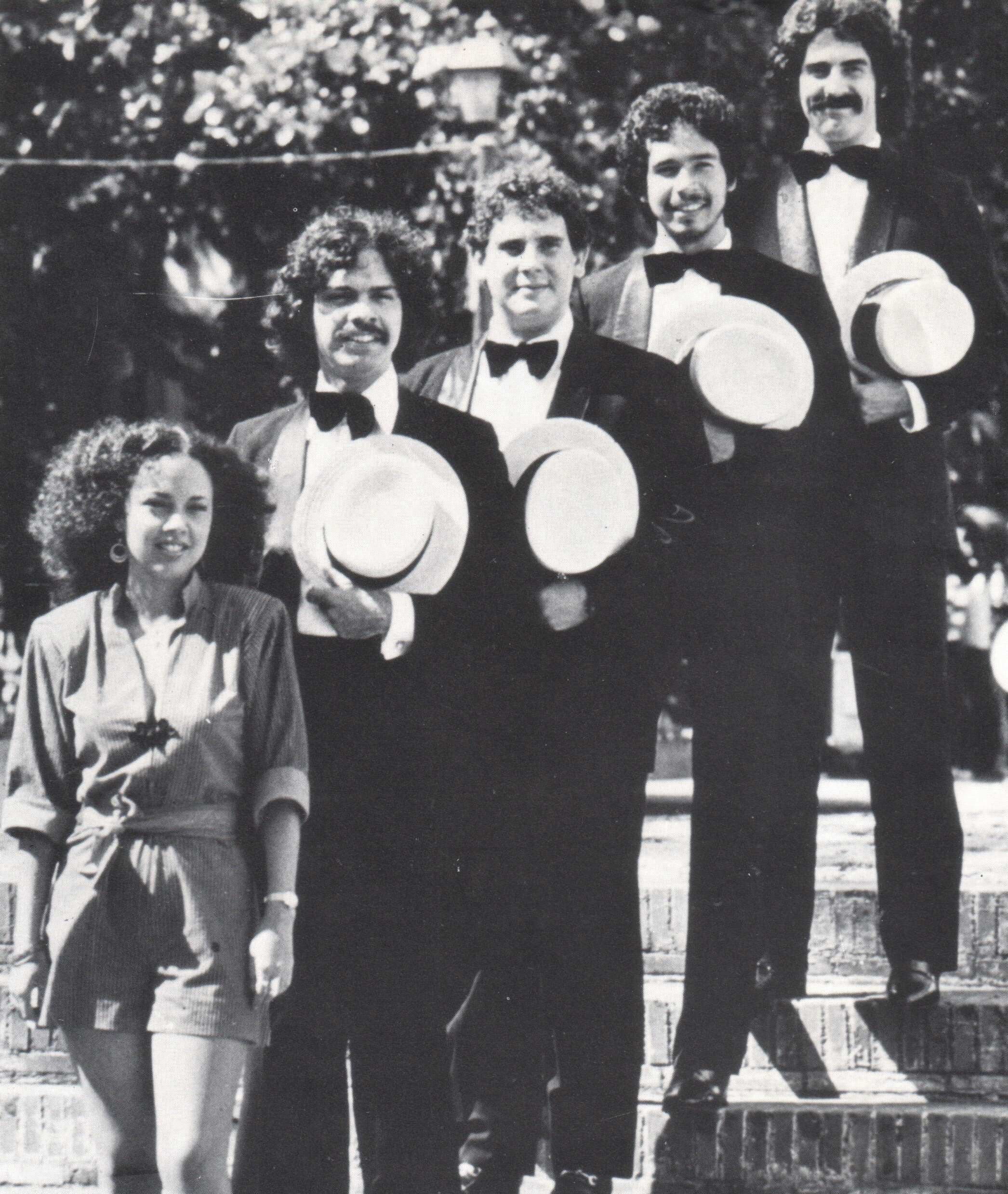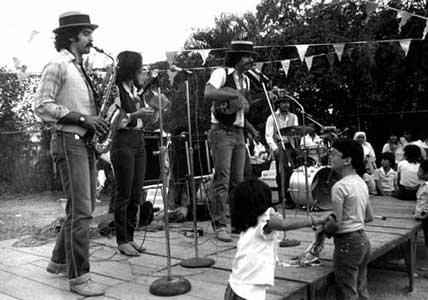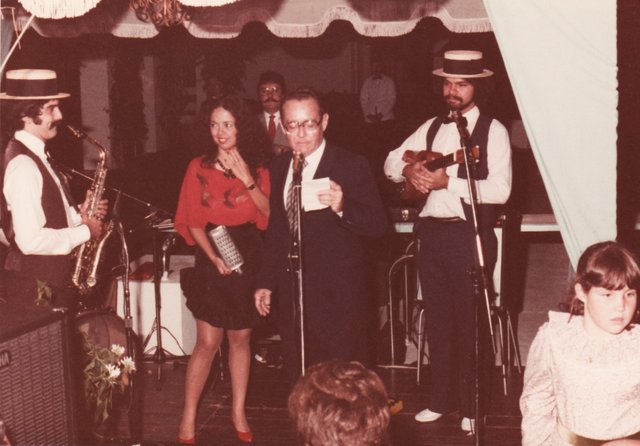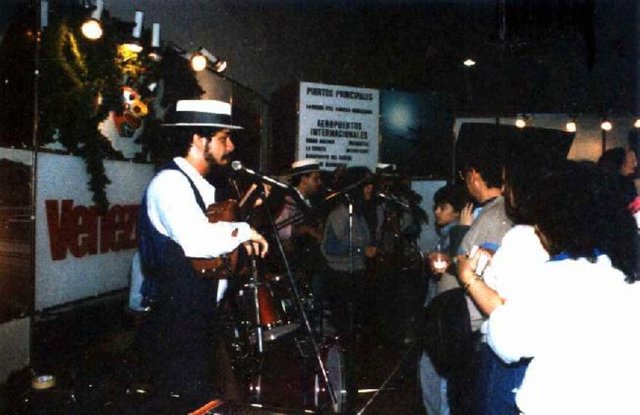Los Cañoneros and me, a history (2)
I'm publishing this post on November 20, just the day we celebrate 36 years since our first show.
In the first part of this story (Los Cañoneros and me, a history (1)) , I told how the whole previous stage was until the group was born. Today I would like to review what was the first stage of Los Cañoneros and, while telling the story, have a look at what elements led to such success, since this is one of the most interesting aspects of this story.
If all the aspects that came together for the projection of the group work, would have been designed by a marketing company, we could conclude that it was an extraordinary and outstanding work, but the truth is that many of the factors happened in a fortuitous way and some of them were taking shape by themselves.
¡Versión en español disponible en este enlace!

Album "Los Cañoneros" (1986)
By the time the group breaks into the local scene, it can be said that the only active group that played cañonera music, were "Los Antaños del Stadium" (Read more about this group in Los Antanos del Stadium in #danceweekend [English-Spanish-Deutsch]).
They represented something like what the Skatalites of the ska scene in Jamaica, or the Preservation Hall Jazz Band in the Dixieland of the United States were. That is, legendary groups, with very old members and an extremely long career. Groups that become almost museum references.
Of course, a group of young people between 18 and 25 years old, looking more like rockers than folklorists, playing that music was already a novelty.
For the time of recording the first album, it is important to remember, we had hardly rehearsed for six months. Basically what we did was to repeat and improve the interpretation of each song, but there was no deeper approach to "concept". But what began to define a "personality" in the group were the different influences that each one of us had.
Let's see each one of the members.
Hely Orsini, Soloist voice

Hely, the lead voice in Los Cañoneros
Hely, as I had her training in Europe and her musical beginnings were there, playing Latin American and traditional Venezuelan repertoire. In 1982, when we started with Los Cañoneros, Hely was living in Mexico and there had already advanced a musical career, which included a solo album. She sang the aforementioned musical genres and part of the new Latin American repertoire, which was very important in Mexico.
Her first solo album, also included songs from Finland, Tanzania and South Africa. She was in the same musical environment and at the same level of singers as Tania Libertad, Eugenia León and Guadalupe Pineda, among others.

Hely, Ylich, Andrés, Arnaldo and Augusto
Augusto Rousset
The saxophonist of the group, when we began to rehearse the repertoire of the play "The True Story of Alma Llanera", had just 6 months studying the instrument. However, being the son of a violinist had made him well informed musically. He was a lover of jazz and most of his study exercises were based on this musical genre.
Andrés Rousset
The youngest of the group was studying cello when entering the group. Despite his studies in classical music, he was the rocker of the group and was responsible for creating one of the fundamental characteristics that still distinguish this group. The use of bass was always one of the elements that added modernity to the sound of Los Cañoneros. In honor of truth, we must recognize that many of the harmonic "innovations" that we incorporated into our work were the product of ignorance. Years later it was that I began to understand them and to systematize them in the arrangements.
Arnaldo Sánchez
Arnaldo had time accompanying me in a traditional music group (a group of "gaitas" a musical genre from western Venezuela), as a percussionist. His main passion was salsa and in that genre he played several instruments such as the tumbadora, bongo and timbales. As he was a good musician, I invited him to participate in the play, where he only had to play the snare drum, but as we began to rehearse, he added drums, first the bass drum, then a saucer, etc., until He finally had a full drum set and became a drummer.
However, we must remember that his main passion was salsa and gaitas.
Myself
I've talked a lot about my training so far, but we can add here that when we started with the Los Cañoneros project, I still leaded a group of gaitas, a musical genre that I had studied and researched for several years. Additionally, I was rehearsing as a singer in a rock group, within the style that became known in Venezuela as "national rock" that had its main influences in Heavy Metal.
Of course, from the moment I was assigned the musicalization of the play, I dedicated myself to investigate the origins and characteristics of this musical form.
The amalgam

Los Cañoneros in a charity event for popular sectors
As I explained before, although there was no specific concept of what we wanted to achieve, the influences of each one had an impact on the overall sound of the group. The arrangements that I made were enriched with new elements in each rehearsal. What was clear to us was that we did not want to play the songs as if they were museum pieces. From the beginning we knew that we were looking for our original sound.
The crash
However, when we arrived at the recording studio, serious conflicts arose. We arrived as youngsters and we were in the hands of a producer with many years of experience, Nucho Bellomo, producer of any number of successes and, as expected, he imposed his criteria. The result was a material of excellent quality, but that playing live was far exceeded. The album did not show the force that the group had live. However, it was a production that achieved extraordinary success.

Playing at a private party
A fundamental aspect that allowed us to reach so many places and such a varied audience is that because it is traditional music, a manifestation of deep historical character and linked to the cultural identity of Caracas, we could participate in educational events, make didactic concerts. Because of the power of the group's music and the youthful aspect in those beginnings, we entered into all kinds of youth events, youth parties. Being a memory music, we also have room in events for seniors, to remember times of yesteryear. And because it is dance music, with more reason we enter into parties of any kind.
But without diffusion and without support, we can not get anywhere. And in our case, we had a lot of support and dissemination. Here enter other very interesting aspects of this story.
"El armoniquero" (the mouth-organ player) is an original merengue, my composition, which is part of the repertoire of the album "Los Cañoneros", published by Top Hits in 1986.
There was a very important factor that was a law promulgated by the President of the Republic in the 80s, which obliged the radio station to place a song by a national artist for each foreign song that sounded. Although that law was mocked by most radio stations and the least favored music was Venezuelan, contributed to the consolidation of a musical movement, which is known as the movement of the 80's in Venezuela, from which emerged many Venezuelan stars. We also benefited from all that wave that was unleashed. That historic moment well deserves a review in the near future.
The fact of coming from the circles of the theater and the intelligentsia, professionally and familiarly, placed us very embedded in that environment, which is why events such as national and international theater festivals, the celebration of the National Day of the Theater and others linked to the cultural activity in general, have been natural scenery for the group.
But from the very beginning we also entered the world of show business, because of the media that were so impacted by the image and sound of this quintet. In that sense it had a great influence the support we received from some people who were key pieces in taking us to such a high projection.
In the previous post I named some who contributed in the first stage, but then there were others that I call them "patrons", because their role was decisive for us to turn Los Cañoneros into a profitable company. Here are three names in first order.
Amador Bendayán

Hely talks with Amador on Sábado Sensacional
Amador was a very famous Venezuelan actor and animator, who led for almost 17 years the most watched program of Venezuelan television, a variety show with the highest rating in the entire television history of the country. He was always a lover of the customs of the city and from the first performance of the group in his program Sábado Sensacional, he fell in love with our musical proposal. Although he was not the producer of the program, his word was taken as an order. With an almost monthly frequency, Amador asked to invite us to the program, which is why our performances in that Saturday program were constant, which gave us an unprecedented popularity.
Billo Frómeta
Of this Dominican musician and his orchestra I have already spoken before (Billo's Caracas Boys - Latin dance big band (English- Español-Deutsch)). However, I have done it to tell of the enormous success and its historical importance in popular music in Venezuela. But Billo was also a lover of the "Caracas of the red roofs" (a way to refer to the Caracas of the early twentieth century, just when the cañonera music was born) and also he became an adept to our music, to such an extent , that while the other Venezuelans hired him and his orchestra to animate their parties, he hired us to liven up his owns. For that same admiration for our work, Billo hired us on different occasions to alternate with the orchestra, especially in events dedicated to the city.
Guillermo Valentiner

At the time of being presented by Valentiner
This businessman of German origin was also a lover of Caracas customs and cañonera music and very soon he became one of the main promoters of the group's activities, not only in this first stage, but also until many years later, as I will tell in a next post. He was responsible of two of the trips we made outside of Venezuela, to the United States, in New Orleans, the birthplace of Dixieland and ragtime, which in turn indirectly caused the birth of cañonera music, and to Germany, where we had the pleasure to perform at the Cotton Club in Hamburg, as well as on boat trips across the Rhine, in the city of Cologne and for the Kölner Ruderverein (Association of Rowers of Cologne). We also had the great pleasure of returning to the beloved city of Leipzig, where we performed in a night club that I do not remember the name.
Many more
Of course, these are not the only ones. There were whole family groups that became our regular patrons, hiring our services for all their events that could be up to more than one per week, for years...
There were many people who opened doors that led us to the most important national and international stages.
Some of these trips were a very special experience, such as the trip to the Azores Islands, where the First International Merengue Festival was organized, with incredible prizes. And when we talk about merengue, we are referring to the Venezuelan merengue, the Caracas merengue. Something unprecedented for this musical genre.
 |  |  |
|---|
"El martirizado" (The martyred), another original composition, from the same album "Los Cañoneros", during another of so many performances on Sábado Sensacional.
One of the aspects that most impressed us of all these trips is that the public was always local, it was not about Venezuelans living in other countries. Therefore, to be successful in these countries, was to have reached the hearts of people of different cultures and languages.
Madrid and Córdoba in Spain, New Orleans in the United States; São Miguel in the Azores Islands in Portugal, Paramaribo in Suriname, Georgetown in Guyana, Port of Spain and Lopinot in Trinidad and Tobago; Cologne, Hamburg and Leipzig in Germany, witnessed an extraordinary success of a musical manifestation born in Caracas around 1920 and that proved to continue to be valid and in force.

Astid Carolina Herrera - [ Source]
There is a funny anecdote with one of those trips. At that time I always fell in platonic love with famous women and I had fun with that, boasting and "crying my loneliness." In 1984 Astrid Carolina Herrera was crowned Miss Venezuela and then Miss World. As I used to I fell in love with her and I lived "torturing" my friends with my lack of love...
These girls, the misses, have always fulfilled the task of tourist promoters and that is how it was at that time. In January 1985, Astrid Carolina announced that Venezuela was going to participate in the International Tourism Fair of Madrid FITUR 85 and that she would represent the country. My sister, laughing, showed me the newspaper and told me that there was my opportunity to go on a trip with "my girlfriend". I went directly to the Ministry of Tourism, where they were delighted that a group as famous as ours wanted to participate in that event. In less than a month we were taking the flight to travel to Spain, although without Astrid Carolina, because she finally did not travel. But this allowed Los Cañoneros to participate in this extraordinary international event, from which also came out the invitation to participate in the carnivals of the city of Córdoba, in Andalusia.
 |  |
|---|
We recorded three albums at that time, plus a special edition that was made for the Canary Islands, Spain, with the quintet format. El Besaor, which was the first of them; Amor de a medio, Vol. 2, our second record production and the last one we did with producer Bellomo. Although our relationship with the record label Palacio de la Música and its owner, the German Ernesto Aue, was extraordinary, we decided to change the label to have the freedom to make an album under our own criteria and with a producer who could understand our proposal.
That's how we signed with the Top Hits label, from another businessman, also German, Wilhelm Ricken. As a record producer we had the excellent Mexican musician and best friend Luis Oliver. There we recorded the album that by title had "Los Cañoneros", which was not well understood by the label and to which they gave almost no promotion. This was in 1986.

Performing for Suriname television
For the following year, we had already had five years of continuous and intense activity, which reached up to three performances in the same day and many times in distant cities.
Apart from that it already implied being together all the time, the singer had her relationship with the saxophonist and since the bass player was his brother and she was my sister, even when we were not working we spent all of our time together. This brought with it a level of fatigue that made relationships so difficult among us that I said I was going to retire in December 1987 and that I left the group for them to go on without me. But at that time no one was in the mood for it, so it was practically sentencing the end of the group.
Given this situation, we decided that we would end up fulfilling some commitments that were pending for 1988.
This story will continue…
One of the last performances of that first stage. The track is part of the album "Los Cañoneros" and it's a song by the Argentinean rocker Litto Nebbia, "Solo se trata de vivir" (It's just about living), covered to Venezuelan merengue.
All images are my property, some exposed on social networks and on the group's website:
The most recent albums of Los Cañoneros are available in:


Follow - Upvote - Resteem
Recent posts / Artículos recientes / Kürzliche Posts
- Goodbye Miguel Blanco / Adiós a Miguel Blanco [En-Es]
- Camerata Punta del Este [En] [Es] [De]
- Raptor House & Tukis in #danceweekend [English - Español - Deutsch]
- Balada Para un Loco (Ballad for a mad man) Camerata Punta del Este
- La paloma (Gaita de tambora) [En-Es-De]
- Los Cañoneros and me, a history (1)
Congratulations! This post has been upvoted from the communal account, @minnowsupport, by stimu from the Minnow Support Project. It's a witness project run by aggroed, ausbitbank, teamsteem, someguy123, neoxian, followbtcnews, and netuoso. The goal is to help Steemit grow by supporting Minnows. Please find us at the Peace, Abundance, and Liberty Network (PALnet) Discord Channel. It's a completely public and open space to all members of the Steemit community who voluntarily choose to be there.
If you would like to delegate to the Minnow Support Project you can do so by clicking on the following links: 50SP, 100SP, 250SP, 500SP, 1000SP, 5000SP.
Be sure to leave at least 50SP undelegated on your account.
Hi ylich,
Visit curiesteem.com or join the Curie Discord community to learn more.
interesante tu historia un abrazo
Hi @ylich , love your post, I read the first part, and enjoyed so much with the videos!! You and your group are part of that Venezuela we want back to us again!! Thanks, you made me feel happy with this extraordinary article.
Hello @ylich, thank you for sharing this creative work! We just stopped by to say that you've been upvoted by the @creativecrypto magazine. The Creative Crypto is all about art on the blockchain and learning from creatives like you. Looking forward to crossing paths again soon. Steem on!